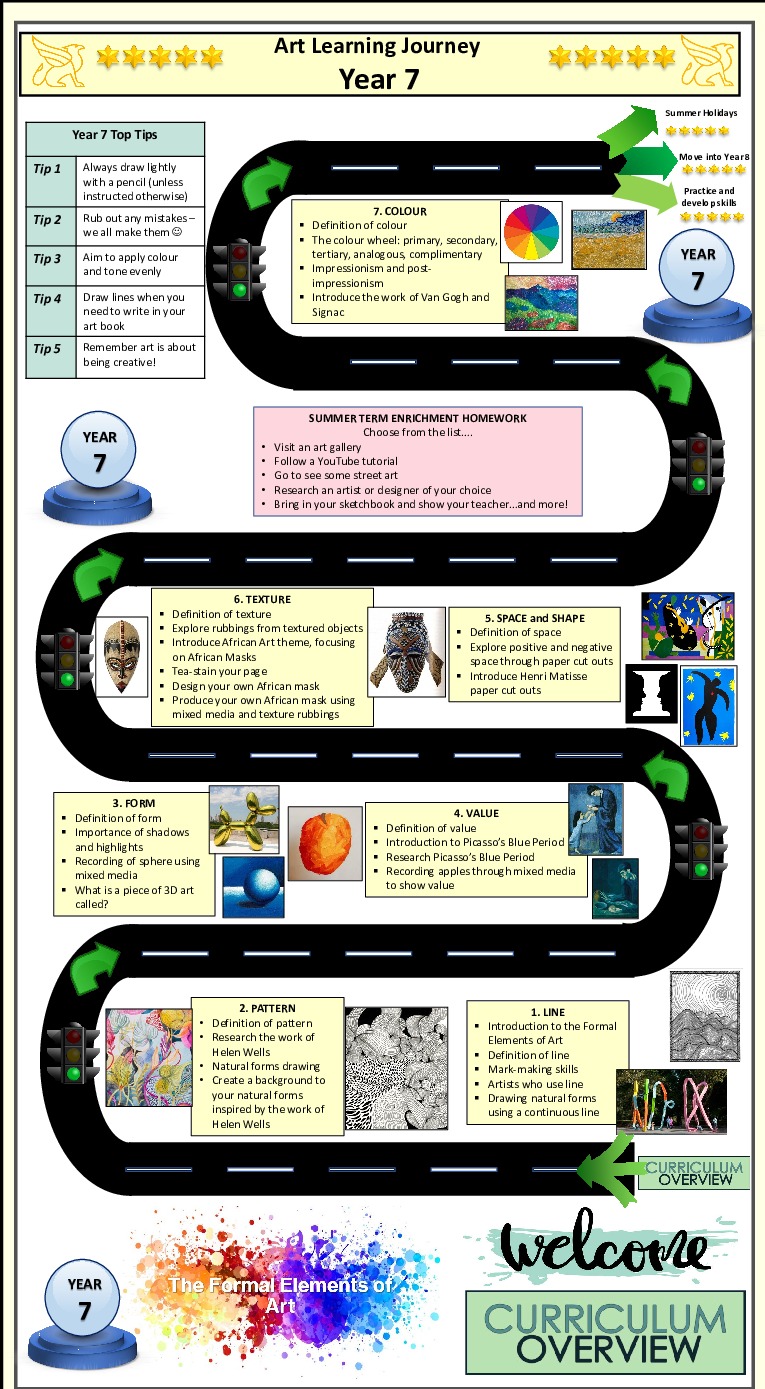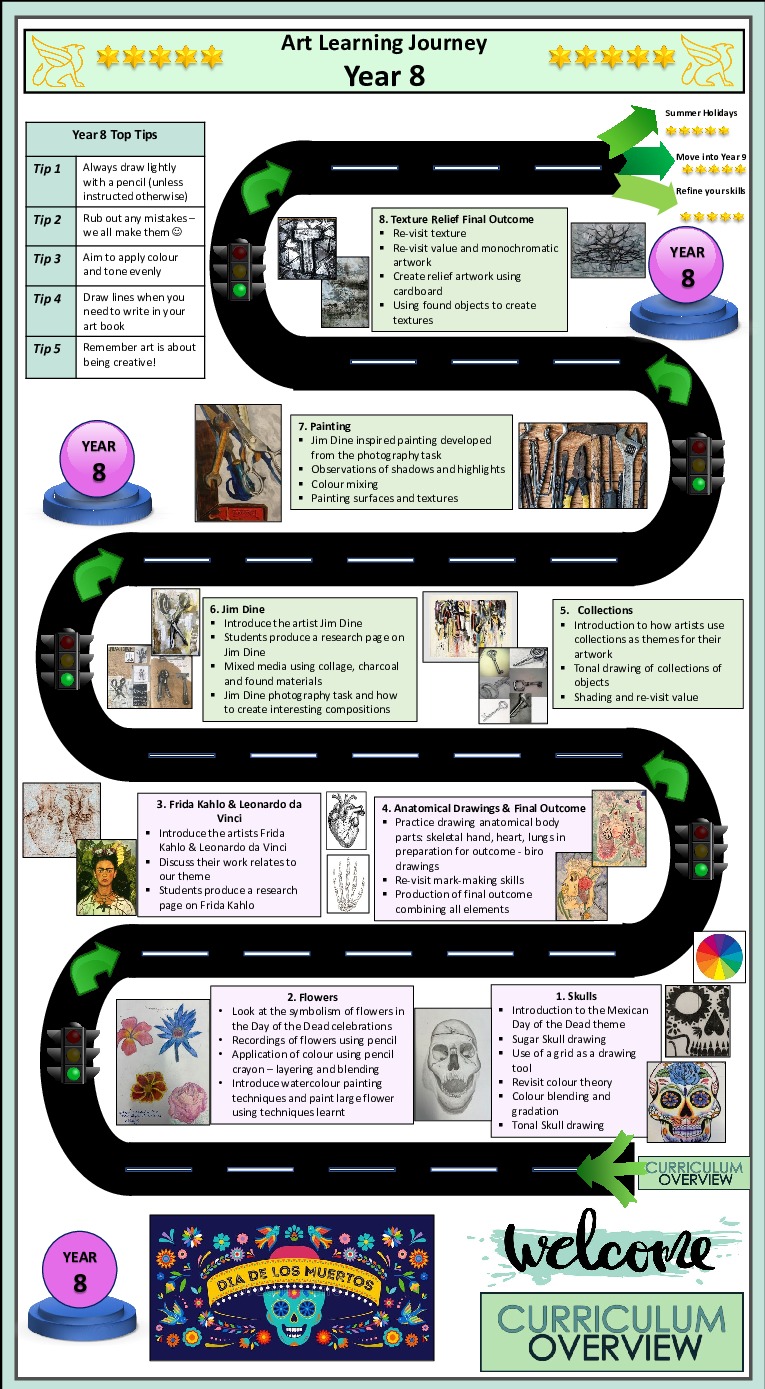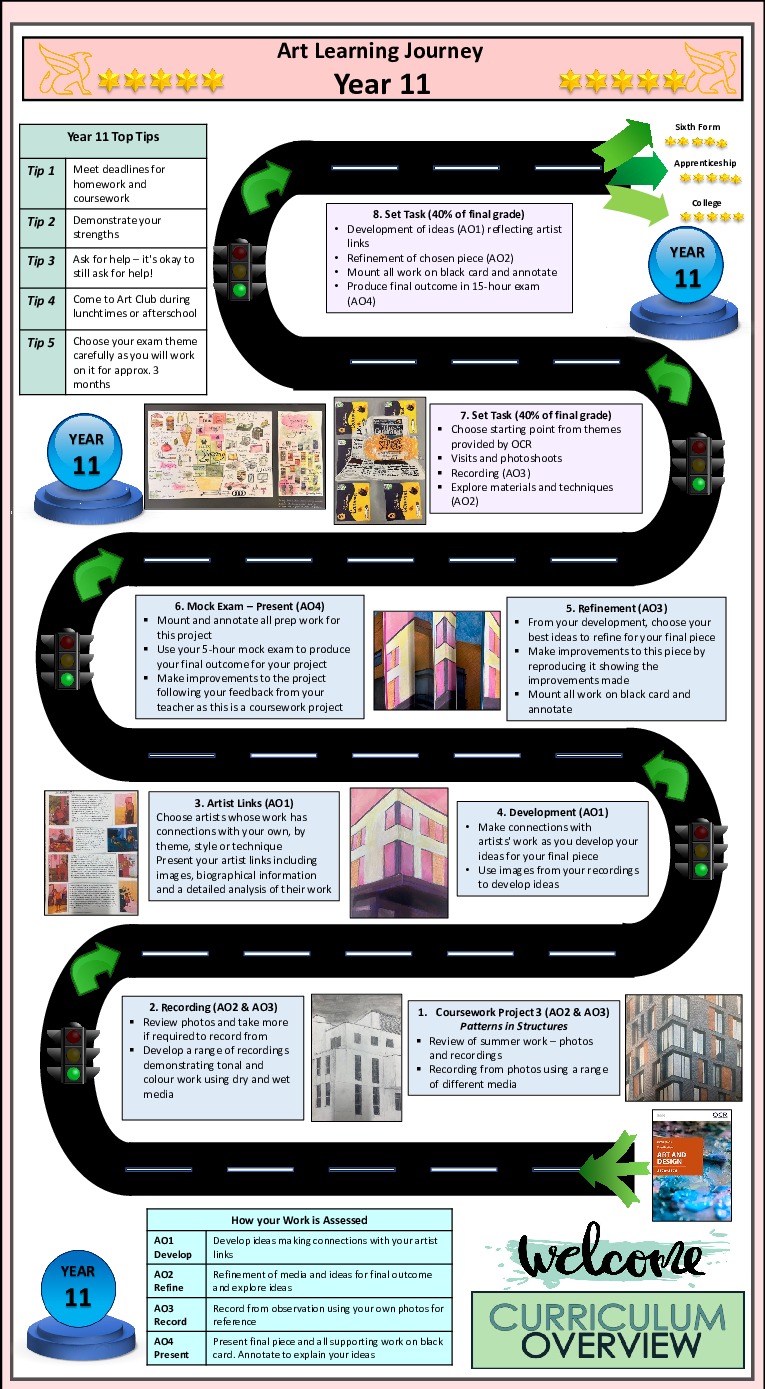Art
BackArt is the application of creative ideas through a range of different skills and techniques: it teaches you how to observe and how to show what you have observed through a range of different media. Art is about being inspired by others and reflecting on their work to influence your own.
Learning Journey





Curriculum Overview
| Year 7 | Term 1 | Term 2 | Term 3 |
|---|---|---|---|
| Key Topic: |
Mark-making & Pattern |
Line |
Value, Form & Colour |
| New Knowledge: |
|
|
|
| Previous Knowledge Required: |
|
|
|
| New Skills: |
|
|
|
| Links to the School Curriculum: |
|
|
|
| Independent Activities: |
|
|
|
| Weblinks: | https://www.youtube.com/watch?v=8767hxeNkL8 |
Youtube - Continuous line drawing of a man
|
https://www.youtube.com/watch?v=AAwYHNo31ZQhttps://www.youtube.com/watch?v=9DIPs3T2dQkhttps://www.youtube.com/watch?v=RuV81WORajkhttps://www.youtube.com/watch?app=desktop&v=TknSnUJSetE |
| Year 8 | Term 1 | Term 2 | Term 3 |
|---|---|---|---|
| Key Topic: |
Mexican Day of the Dead – Recording from Observation |
Mexican Day of the Dead – Watercolour Painting & Final Outcome |
Portrait Drawing – Developing into Political Portraits |
| New Knowledge: |
|
|
|
| Previous Knowledge Required: |
|
|
|
| New Skills: |
|
|
|
| Links to the School Curriculum: |
|
|
|
|
Independent Activities: |
|
|
|
| Weblinks: | https://www.youtube.com/watch?v=xUR8Iy6aXcshttps://www.youtube.com/watch?v=u9uyhhb2W30https://www.youtube.com/watch?app=desktop&v=qSim0oOvioA | https://www.youtube.com/watch?app=desktop&v=8FHrhH9k-PYhttps://www.youtube.com/watch?app=desktop&v=83C5oitfM2Ihttps://www.youtube.com/watch?app=desktop&v=tb8cU9MmIl8https://www.youtube.com/watch?app=desktop&v=3INvtEoBkpM | https://www.youtube.com/watch?app=desktop&v=LasPQtLzOkchttps://www.youtube.com/watch?app=desktop&v=UBwNVuoKPSUhttps://www.youtube.com/watch?app=desktop&v=fesjv1egfxkhttps://www.youtube.com/watch?app=desktop&v=iMCxtFmzmxMhttps://www.youtube.com/watch?app=desktop&v=q_EOzZ9iaJQ |
| Year 9 | Term 1 | Term 2 | Term 3 |
|---|---|---|---|
| Key Topic: |
Steam Punk Insects |
Steam Punk Glasses Design |
Chuck Close Portraits |
| New Knowledge: |
|
|
|
| Previous Knowledge Required: |
|
|
|
| New Skills: |
|
|
|
| Links to the School Curriculum: |
|
|
|
|
Independent Activities: |
|
|
|
| Weblinks: | https://www.youtube.com/watch?v=69-pJCgF5QQ | https://thekidshouldseethis.com/post/kenyan-artist-cyrus-kabiru-makes-eyeglasses-from-trash-e-waste | https://www.youtube.com/watch?v=UHqGxIMxRbghttps://www.youtube.com/watch?app=desktop&v=milXH-433vs |
| Year 10 | Term 1 | Term 2 | Term 3 |
|---|---|---|---|
| Key Topic: |
Natural Forms – Recording from Observation |
Natural Forms - Printmaking |
Man-made Structures |
| New Knowledge: |
|
|
|
| Previous Knowledge Required: |
|
|
|
| New Skills: |
|
|
|
| Links to the School Curriculum: |
|
|
|
|
Independent Activities: |
Visit art galleries and museums to see art first hand and make connections with your own work. Evidence this in your coursework where relevant.
Research more artists or printmakers who have used natural forms (specifically your chosen area of natural forms) as inspiration for their own work. Those who are aiming for the highest grades need to work independently to produce more than the minimum amount of work which is that set by the class teacher. They should complete more pieces of recording; more development pieces; more pieces of refinement and use more artist links as their work develops. |
Visit art galleries and museums to see art first hand and make connections with your own work. Evidence this in your coursework where relevant.
Research more printmakers who have used natural forms (specifically your chosen area of natural forms) as inspiration for their own work. Those who are aiming for the highest grades need to work independently to produce more than the minimum amount of work which is that set by the class teacher. They should complete more pieces of recording; more development pieces; more pieces of refinement and use more artist links as their work develops. |
Visit art galleries and museums to see art first hand and make connections with your own work. Evidence this in your coursework where relevant.
Research more artists who have produced drawings or paintings of architecture. Produce these as artist links and use their inspiration to develop your own ideas. |
| Weblinks: | https://ocr.org.uk/qualifications/gcse/art-and-design-j170-j176-from-2016/ | https://www.youtube.com/watch?v=3EJaQdUSyN0https://www.youtube.com/watch?app=desktop&v=k8lhESQ-bKs | https://www.youtube.com/watch?app=desktop&v=V6ZT1705Slwhttps://www.youtube.com/watch?app=desktop&v=V6ZT1705Slw |
| Year 11 | Term 1 | Term 2 | Term 3 |
|---|---|---|---|
| Key Topic: |
Close Up Structures/Mock Exam |
GCSE Exam Prep |
N/A |
| New Knowledge: |
|
|
|
| Previous Knowledge Required: |
|
|
|
| New Skills: |
|
|
|
| Links to the School Curriculum: |
|
||
|
Independent Activities: |
|
|
|
| Weblinks: | https://ocr.org.uk/qualifications/gcse/art-and-design-j170-j176-from-2016/ |
|

